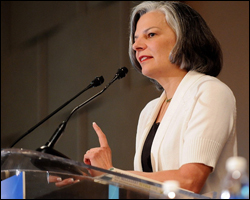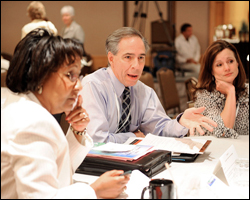Leaders Amplify Healthiest Nation Aims
Published: September 29, 2008
The United States spends more than any other nation in the world on health, over 2 trillion dollars per year, yet we do not rank in the top 10 on any world measure of health. Why is this? Primarily because as a nation we are not focusing on health and sustaining health. Only 3 percent of our annual health expenditures are spent on preventing disease; rather 97% is spent largely on care and most of that on consequences of preventable chronic diseases and most of it in the last years of life. Additionally we have over 40 million people without health insurance, and large numbers experiencing preventable disease; as examples, more than 500,000 are living with HIV and approximately 24 million with diabetes. As the nation's health agency, it is important for the Centers for Disease Control and Prevention (CDC) to lead the way and to join forces with leaders across the country to create solutions to become a healthiest nation.

Julie L. Gerberding, MD, MPH, articulates the theme of the weekend and stresses the importance of collaborations in improving the health of the nation.
Recently, in Washington, DC, the third annual Leaders-to-Leaders Conference brought together senior executives in business and media, government, education, non-profit, and faith-based and community sectors to discuss ideas on actionable policies, strategies, and the use of innovative technologies to improve the US population's health. The conference was hosted by:
- CDC's Division of Partnerships and Strategic Alliances
- CDC's Office of Strategy and Innovation
- National Association of County and City Health Officials (NACCHO)
- Association of State and Territorial Health Officials (ASTHO)
"When networks and community organizations come together they have an extraordinary amplifying effect and the ability to create and harness change," said CDC Director, Julie Louise Gerberding, MD, MPH, during opening remarks. "The day we elect our mayors based on the health status of the community, at the same time that we are thinking about the number of potholes and the educational system in the community, is the day that we will have transformed our health system."
This year's conference, "Shaping Policy for a Healthier Nation," focused on the conference's goals to:
- Identify policies and actions that will have the greatest likelihood of improving the health of Americans, along with what it will take to "bring policies to life"
- Generate actionable ideas to encourage Americans to take steps to prevent disease
- Determine specific mechanisms to continue information sharing and collaboration around local, state, regional and national efforts to transform the health system through policy development and implementation
"As leaders, as citizens, as people, we must ask ourselves, 'What can I do to bring about a healthier people… to bring about a healthier world?'" said Paul Jarris, MD, MBA, executive director, Association of State and Territorial Health Officials (ASTHO). "The collective effort is what drives change in the nation, but it is the individual participation that moves the change forward."
Conference participants engaged in several roundtable discussions that explored not only policy, but also the responsibility of the individual to improve the health of the nation.
Topics ranged from "Finding the Voice of Public Health in the National Health Reform Dialogue" to "Using the Language of Leadership to Shape Policy for a Healthier Nation." Discussions offered a venue to address how the nation talks about health care in terms of policy development. CDC staff who attended the conference served as observers and facilitators of the group discussions.
"Right now, most of the conversation regarding health is about healthcare reform, which focuses on problems in quality, value, and access. However, the big conversation revolves around what we value," said Gerberding.

Conference participants engaged in roundtable discussions that not only explored policy, but also the responsibility of individuals to improve the health of the nation. Photo by Denny Henry
Panel discussions such as "Innovations in Technology with Health Impact Potential," examined technologies to determine how people send and receive health information. Panelists highlighted the need to expand policy changes and reach those in the country who once had limited access to health information.
"Over 80 percent of the world today does not have an e-mail address or Internet access, so providing information via mobile devices and having it interoperable is going to be key," said Todd Wiseman, manager, Google's Federal Civilian Enterprise Team.
The theme of the 2008 Leaders-to-Leaders Conference was inspired by the Healthiest Nation Initiative and the new Alliance for the Healthiest Nation,* a public/private partnership which began as a collaboration of three governmental health organizations—National Association of County and City Health Officials (NACCHO), ASTHO, and CDC.
"Our job, if we want to be the healthiest nation, is to create the conditions in which everyone has the opportunity to succeed," said Bobby Pestronk, MPH, health officer, Genesee County, Michigan, who served as the moderator for a panel on health equity.
The Alliance capitalizes on the unique role of governmental public health as a "connector," to help create a new health system that leverages existing relationships into a unified effort. It also has the unique capacity to link the idea of public health with health equity, community welfare, social responsibility, national security, customer-centricity, and the economic and political issues that bear on public policy
Becoming the healthiest nation may seem to be an insurmountable task. However, as Nick Baird, MD, executive director, Alliance for the Healthiest Nation, explained, "Engaging consumers—individuals, business, and organizations—in health systems and empowering them to take responsibility for creating change within their piece of the system can change the debate from a focus on health care, with its discussions on access and cost, to a more proactive, prevention-focused, national discussion on health."
Baird also added, "We must change how we define a successful health system, from one that measures disease and 'unhealthiness' to one that measures health by engaging users of the system where they live, work, shop, go to school, and play, and providing specific actions that they can take immediately to create their healthiest home, healthiest organization, and healthiest community."
During the conference, leaders were invited to become official members of the Alliance and commit to doing three things:
- Support the Healthiest Nation and engage in the conversation for health
- "Walk the talk" by taking at least one specific action to improve and model health
- Share their successes
More Information
- 2008 Leaders-to-Leaders Conference Information and Webcasts
- CDC Partners
- National Association of County and City Health Officials
- National Network of Public Health Institutes
- Podcasts at CDC
- The Association of State and Territorial Health Officials
- Alliance for the Healthiest Nation
* Name changed slightly upon formation, Fall 2008.
Related Links
Get email updates
To receive email updates about this page, enter your email address:

